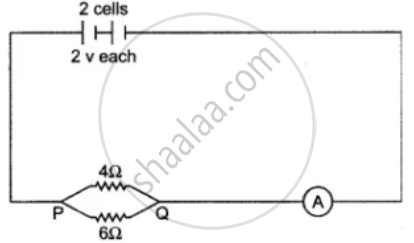Advertisements
Advertisements
प्रश्न
With reference to the diagram shown below calculate:

(i) The equivalent resistance between P and Q.
(ii) The reading of ammeter.
(iii) The electrical power between P and Q.
उत्तर
(i) `1/"R" = 1/4 + 1/6 = (3 + 2)/12 = 5/12`
So, equivalent resistances
`= 12/5 = 2.4 Omega`
(ii) Here, R = 2.4 Ω
E = 2 × 2 = 4 V
From E = IR
I = `"E"/"R"` or I = `4/2.4 = 1.66` A
(iii) Power between P and Q
= I2R
= (1.66)2 × (2.4) = 6.66 watts
APPEARS IN
संबंधित प्रश्न
Which uses more energy, a 250 W TV set in 1 hr, or a 1200 W toaster in 10 minutes?
A geyser is rated 1500 W, 250 V. This geyer is connected to 250 V mains. Calculate:
(i) the current drawn
(ii) the energy consumed in 50 hours, and
(iii) the cost of energy consumed at Rs. 4.20 per kWh
What would happen and why, to an electric bulb when it is connected across a supply of voltage (i) lower (ii) higher than its proper rating?
An electric bulb is marked 100 W, 230 V. What does this mean?
How does the heat produced by die passage of current in a metallic wire depend on the resistance of the wire.
Three 250 W heaters are connected in parallel to a 100 V supply, Calculate the resistance of each heater.
An electric kettle is rated 3kW, 250V. What should be the current capacity of the fuse with it?
An electric bulb is rated as 100W – 250V. What information does it convey? Calculate the resistance of its filament while glowing.
Two resistances R1 = 4Ω and R2 = 6Ω are connected in series. The combination is connected with a battery of e.m.f. 6V and negligible resistance. Calculate:
(i) the heat produced per minute in each resistor,
(ii) the power supplied by the battery.
